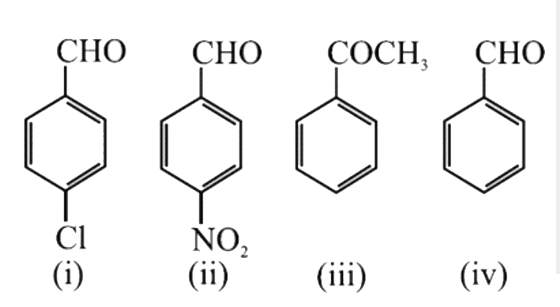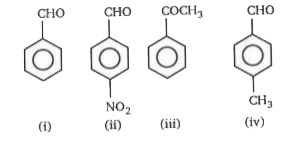Reaction of carbonyl compound with one of the following reagents involves nucleophilic addition followed by elimination of water. The reagent is:
a Grignard reagent
hydrazine in presence of feebly acidic solution
hydrocyanic acid
sodium hydrogen sulphite
To solve the question regarding which reagent leads to nucleophilic addition followed by elimination of water when reacting with a carbonyl compound, we will analyze each of the given options step by step.
1. Understanding the Reaction:
- Carbonyl compounds (aldehydes and ketones) undergo nucleophilic addition reactions. A nucleophile attacks the electrophilic carbon atom of the carbonyl group, leading to the formation of an intermediate.
- In some cases, this intermediate can lose a water molecule, resulting in a condensation reaction.
2. Analyzing the Reagents:
- a. Grignard Reagent (RMgX):
- Grignard reagents are strong nucleophiles that react with carbonyl compounds to form alcohols. However, they do not lead to the elimination of water; instead, they add to the carbonyl carbon and do not form a double bond or eliminate water.
- b. Hydrazine in Presence of Feebly Acidic Solution:
- Hydrazine (NH2NH2) can react with carbonyl compounds to form hydrazones. In the presence of a weak acid, the nucleophilic addition occurs, followed by the elimination of water to form a double bond between the carbon and nitrogen (C=N). This fits the requirement of the question.
- c. Hydrocyanic Acid (HCN):
- Hydrocyanic acid can also act as a nucleophile, but it does not lead to the elimination of water. Instead, it forms cyanohydrins, which do not involve the loss of water.
- d. Sodium Hydrogen Sulfide (NaHS):
- Sodium hydrogen sulfide can react with carbonyl compounds to form thioacetals, but it does not involve the elimination of water in the way described in the question.
3. Conclusion:
- The reagent that involves nucleophilic addition followed by elimination of water is b. Hydrazine in presence of feebly acidic solution.
Final Answer:
b. Hydrazine in presence of feebly acidic solution
- Carbonyl compounds (aldehydes and ketones) undergo nucleophilic addition reactions. A nucleophile attacks the electrophilic carbon atom of the carbonyl group, leading to the formation of an intermediate.
- In some cases, this intermediate can lose a water molecule, resulting in a condensation reaction.
- a. Grignard Reagent (RMgX):
- Grignard reagents are strong nucleophiles that react with carbonyl compounds to form alcohols. However, they do not lead to the elimination of water; instead, they add to the carbonyl carbon and do not form a double bond or eliminate water.
- b. Hydrazine in Presence of Feebly Acidic Solution:
- Hydrazine (NH2NH2) can react with carbonyl compounds to form hydrazones. In the presence of a weak acid, the nucleophilic addition occurs, followed by the elimination of water to form a double bond between the carbon and nitrogen (C=N). This fits the requirement of the question.
- c. Hydrocyanic Acid (HCN):
- Hydrocyanic acid can also act as a nucleophile, but it does not lead to the elimination of water. Instead, it forms cyanohydrins, which do not involve the loss of water.
- d. Sodium Hydrogen Sulfide (NaHS):
- Sodium hydrogen sulfide can react with carbonyl compounds to form thioacetals, but it does not involve the elimination of water in the way described in the question.
- The reagent that involves nucleophilic addition followed by elimination of water is b. Hydrazine in presence of feebly acidic solution.
b. Hydrazine in presence of feebly acidic solution
Similar Questions
Knowledge Check
- Question 1 - Select One
Which of the following compounds is most reactive towards nucleophilic addition reactions ?
ACH3−O∣∣C−HBCH3−O∣∣C−CH3C D
D
- Question 2 - Select One
Which of the following compounds is most reactive towards nucleophilic addition reactions ?
ACH3−O∣∣C−HBCH3−O∣∣C−CH3C D
D
- Question 3 - Select One
Which of the following compounds is most reactive towards nucleophilic addition reactions ?
ACH3−O∣∣C−HBCH3−O∣∣C−CH3C D
D
Which one of the following reagents is not suitable for the elimination reaction?
 View Solution
View SolutionArrange the following carbonyl compounds in decreasing order of their reactivity in nucleophilic addition reaction :
 View Solution
View SolutionSelect the reagent for the following reaction
 View Solution
View SolutionWhich of the following compounds is most reactive towards nucleophilic addition reactions ?
View SolutionArrange the following carbonyl compounds in decreasing order of their reactivity in nucleophilic addition reaction.
 View Solution
View Solution

